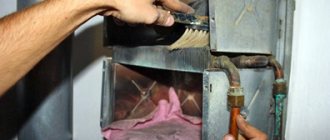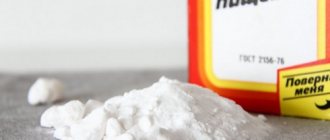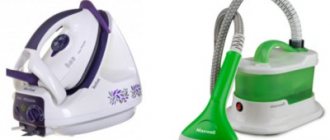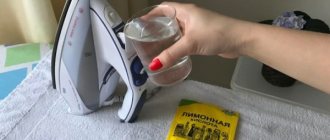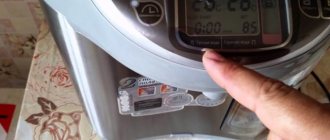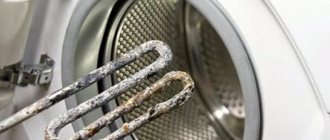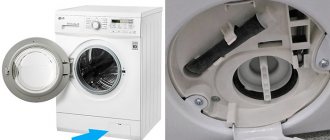Several ways to clean your steamer at home
The methods for cleaning the steamer tank are no different from the same procedure for an electric kettle. Descaling is done using one of the methods well known to housewives.
- The sediment can be removed by boiling water with the addition of citric acid or vinegar. Instead of ordinary water, pour an acid solution into the tank and turn on the device for as long as it can operate without harm. After this, the remaining solution must be drained and the container thoroughly rinsed to remove the acidic solution. You can use a weak solution of soda to completely neutralize vinegar or citric acid, followed by rinsing the tank with clean water.
- Coca-Cola, Sprite or 7UP descale very well. It is better to use colorless carbonated drinks and rinse the device thoroughly to remove any residue.
- In the hardware departments of supermarkets or specialized stores, you can purchase special solutions for cleaning steam generators and steamers. The effect will be the same as from the methods described above, but you will be calmer: everything is “according to the rules.”
Preventing scale formation
The instructions usually write what kind of water can be poured into the steamer tank. For pump devices, it is usually recommended to use only distilled water. Even high-quality filtered water is not suitable for these complex devices. In fact, distilled water is best used in all types of steamers.
Even if some models can be descaled yourself using improvised means, this does not mean that such cleaning does not harm the device.
It is better to avoid scale formation than to perform various manipulations with acids and household chemicals.
Prevention measures
The steamer needs to be descaled due to the use of tap water. Experts recommend pouring filtered or distilled liquid into the compartment. This will reduce the number of cleanings.
Recommended reading: How to remove putty from clothes
Preventive removal of lime deposits promotes adequate operation of the electrical appliance. It is necessary to clean the clothes steamer from scale when deposits appear on the walls of the device and the volume of steam supply decreases. Typically, using high-quality water will extend the interval between cleanings.
It is recommended to purchase models of household appliances with special cartridges designed to soften water. They allow you to fill the tank with regular liquid. If there are no cartridges, you should use the following water options:
- filtered;
- distilled;
- demineralized.
Kalstop Polti can be added before using regular liquid.
How to clean a steam generator at home
Quite often housewives have a question about how to clean a steam generator at home without damaging the equipment. The device is used for ironing and steaming clothes; it is simple and effective to use, but during operation, owners are faced with the problem of scale formation. This is due to the low quality of water, which contains impurities of salts, lime and other contaminants.
You can clean the steamer at home yourself, using special descaling agents or home methods. The article contains effective methods for cleaning a steam generator that will return the device to cleanliness and allow it to function normally.
Is it possible to clean the steamer yourself?
To successfully clean the device at home, you must read the instructions for the device and follow all the rules for handling it.
Also keep in mind that the presence of acid in cleaning products can negatively affect the appearance of a device made of rubber or plastic. And in the worst case, the steam generator may stop working.
Important! Never try to clean a clothes steamer yourself if it supplies water to the heating element using a pump.
If characteristic sounds are made when steaming clothes, then the device has a pump, so only a specialist should repair the steamer. For safe cleaning, he will disassemble the device into parts.
If the entire volume of water heats up during operation, then the device can be cleaned at home without risk.
Features of cleaning steam generators of different models
The choice of cleaning method depends on the type of steam generator. The pump device is easy to use and very effective, but very difficult to maintain. If you take the risk of cleaning it yourself, you can damage the device, so it is better to entrust such a delicate task to the service center specialists.
Gravity steam generators are not as efficient as pump steam generators, but they are easy to maintain and operate. You can clean the device yourself using special descaling compounds or home remedies.
The cleaning method also depends on the model and brand of the steam generator. Most devices from Tefal, Philips, and Bosch are equipped with a self-cleaning system. They can work with liquid of any quality, subject to regular preventive self-cleaning.
Instructions for using the cleaning system:
- Fill the reservoir with water.
- Set the maximum temperature and turn on the device.
- Wait until the system is completely heated, and then turn off the equipment and install it above a bathtub or a special stand.
- Press the dedicated button while holding the device horizontally. The steam coming out of the iron will remove dirt and scale accumulated in the tank.
How to prevent scale formation
Limescale deposits form due to the use of hard water. Many modern steam generator models are equipped with a self-cleaning function, but this does not protect the device 100%.
There are several simple rules for preventing scale in steamers:
- use distilled, filtered or boiled water;
- Always check if there is any liquid left in the reservoir after use. If so, drain it and rinse the container after each use.
Regularly check the device for the presence of scale and do preventive cleaning at least once a month.
Cleaning with folk remedies
You can descale a steam generator at home using improvised means. They effectively cope with the task without damaging the working elements of the device. Next, we will look at the simplest and most effective cleaning methods.
Lemon acid
The procedure for cleaning the steamer with citric acid:
- Prepare a solution of 1 liter of hot water and 25 g of lemon. Stir the ingredients until the crystals are completely dissolved.
- Turn on the steamer to maximum temperature and run the steam mode until the liquid has completely evaporated. When cleaning the steam iron, iron unwanted cotton fabric.
- At the end of the procedure, pour clean water into the tank, wait 15 minutes, and then drain. Repeat the procedure 2-3 times to completely wash away the citric acid crystals.
Vinegar
Instructions for cleaning a steam iron with vinegar solution:
- Mix vinegar and water in equal proportions.
- Fill the tank 25% and install it on the station.
- Wait 20 minutes and then turn on the appliance at full power.
- Set the steam setting and iron the unwanted fabric. This cleaning will additionally remove carbon deposits from the sole of the equipment.
- Rinse the tank several times with clean water.
Cleaning a steamer with vinegar solution is effective and affordable, but the process is accompanied by an unpleasant odor. To avoid deterioration in health, carry out the procedure in a well-ventilated area.
Automatic cleaning
Some steamer models are equipped with a self-cleaning function. During operation, the user, in principle, does not have to think about descaling. The household appliance eliminates it independently according to two schemes:
- automatically during operation - when the steamer sensors show that plaque has accumulated on the walls, the device starts the dirt removal mode;
- provided that the special compartment is filled, you need to pour distilled liquid into a small container; when enough scale has formed, the steamer will go into self-cleaning mode and use up this water.
Units with automatic plaque removal mode are available from Philips, Tefal and Bosch brands. Such models are more expensive than regular ones, but they are much easier to care for and have a longer service life.
Methods for cleaning the steamer soleplate
Often the cause of steam generator contamination is not only scale, but also carbon deposits on the base of the device. This problem can lead to damage to fabrics during ironing and damage to your favorite items. To avoid this, clean the surface in a timely manner using one of the methods presented.
Paraffin and salt
Cleaning procedure:
- Combine crushed paraffin with fine salt and pour onto a sheet of white paper.
- Plug in the iron and use a heated soleplate to iron the mixture until the molten substance covers the entire surface.
- Wipe the cooled iron with a soft, dry cloth.
Dishwashing liquid
To clean the surface from carbon deposits, lime flakes and stains, wipe the sole with a sponge soaked in a weak soap solution. The device should be cleaned in a cold state to prevent dirt from burning even more. After cleaning, wipe the surface with a soft cloth and you can use the ironing device for its intended purpose.
other methods
The following products will help get rid of carbon deposits, rust and other marks on the soleplate of the iron:
- soda _ Combine 100 ml of distilled water (or vinegar) and 2 tsp. soda Rub the resulting paste onto the slightly heated soleplate of the iron, and then clean the surface with a soft piece of cloth;
- toothpaste . The available product will effectively clean the soleplate and steam outlets. Polish the surface with a cotton pad and toothpaste, and then wipe with a clean cloth;
- hydrogen peroxide . Soak cotton wool in a medical product and treat the surface. This product is suitable for irons with ceramic soles.
Use of special means
Special products will help you clean the steam generator from scale. The most famous is “Antinakpin”, which is sold in the form of tablets, gel or powder and is suitable for cleaning household and industrial devices. When using it, you must strictly follow the instructions:
- Dissolve the specified amount of product in distilled water.
- Pour the solution into the tank and leave for half an hour.
- Turn on the steam mode and iron the unwanted fabric until the liquid has completely evaporated.
- Rinse the container with clean water.
Every housewife can clean a steamer at home. To avoid the problem of damaged equipment or clothing, carry out regular preventive cleaning and use distilled water.
Additional tips for cleaning your steamer
- Before cleaning the steamer, make sure that it is not connected to the mains.
- If you don't have vinegar or can't buy a cleaning agent to quickly descale your tank, you can use distilled water. You need to pour the liquid into the container and use the steam release function until the water tank is almost empty.
- Immediately after heating, it is advisable to treat the still hot surface with a sponge soaked in cold water. The temperature difference should help remove any remaining sediment.
- Avoid using cleaners or other abrasive products as they may damage the steamer.
- It is recommended to empty the water tank after each use. This way you can minimize the formation of sediment in the container.
- You can tell that the steamer is calcined if white spots are visible on the iron, or when small white crumbs are released. Also, scale is indicated by difficulty or cessation of evaporation, because the steam nozzle is clogged. After this, you need to descale the device.
Of course, it is better not to wait for complete blocking, but to process the device at certain intervals. You can minimize this unpopular procedure by using distilled water instead of tap water for steaming. You can also pour liquid from the filter into the container, this will prevent the formation of lime in the steamer.
